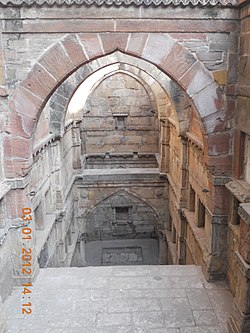| This article needs additional citations for verification. Please help improve this article by adding citations to reliable sources. Unsourced material may be challenged and removed. Find sources: "Amritavarshini Vav" – news · newspapers · books · scholar · JSTOR (January 2015) (Learn how and when to remove this message) |
| Amritavarshini Vav | |
|---|---|
 | |
| General information | |
| Architectural style | Hindu and Islamic architecture |
| Town or city | Ahmedabad |
| Country | India |
| Coordinates | 23°01′30″N 72°35′50″E / 23.02495°N 72.5972°E / 23.02495; 72.5972 |
| Completed | 1723 |
| Technical details | |
| Floor count | Three storied stepwell |
| Designations | S-GJ-1 (state protected monument since 1969) |
Amritavarshini Vav, also known as Panchkuva Stepwell or Katkhuni Vav, is a stepwell near the Panchkuva Darwaja in Ahmedabad, Gujarat, India.
History
Panchkuva, literally five wells, area derived its name the five wells in the area. Amritavarshini vav was completed in 1723 as per Devanagari and Persian inscription ( Vikram Samvat 1779 / A.H. 1135) in the stepwell. It was built by Raja Raghunathdas during his stay in the city from 1721-1722. Raghunathdas was the diwan of Haidar Quli Khan, subahdar (governor) of Gujarat.
Architecture
Sparsely ornamented, Amriavarshini Vav is notable for its L-shaped plan and has simple design. It has three storeys and is more than 50 feet deep. The bracing arches have different shapes at the two storeys and in the kuta (pavilion tower) before the well shaft. It was declared a protected monument in 1969 and was conserved in 1999. It was recharged later by digging in 2004.
Gallery
-
 Right angled construction of stepwell
Right angled construction of stepwell
-
 Inscriptions in the stepwell
Inscriptions in the stepwell
-
 Shaft of the well
Shaft of the well
-
 Steps from inside
Steps from inside
See also
References
- ^ Menon, Lekha (18 November 2004). "A 'step' in time". The Times of India. Retrieved 12 January 2015.
- Mānekshāh Sorābshāh Commissariat (1957). A History of Gujarat: Mughal period, from 1573 to 1758. Longmans, Green & Company, Limited. p. 404.
- "Times of India Publications". Times of India Publications. 24 November 2009. Archived from the original on 12 January 2015. Retrieved 12 January 2015.